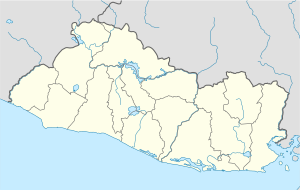Huizúcar facts for kids
Quick facts for kids
Huizúcar
|
|
|---|---|
|
Municipality
|
|
| Country | |
| Department | La Libertad |
| Elevation | 2,000 ft (610 m) |
Huizúcar is a town and municipality located in the La Libertad area of El Salvador. It's the main town of the Huizúcar district. Huizúcar is about 23 kilometers (14 miles) from San Salvador. It sits high up, about 640 meters (2,100 feet) above sea level. The town's special protector, or patron saint, is Saint Michael the Archangel.
Contents
Huizúcar Church: History and Design
The Church of Huizúcar is an old church built in a colonial style. It was constructed in 1740. No one knows for sure who built it. However, many people believe that Friar Martín de Jesús designed the church's plans.
Unique Architecture of the Church
The church has special architectural features. For example, its beams and ceilings show the Mudejar style. This style mixes Christian and Islamic art. The church is built completely from wood. It has a frame of even roofs and large beams. These beams rest on thick wooden pillars. The pillars have bases made of molded brick.
The front of the church, called the facade, has a single main part. It features a triangular shape on the roof. This roof is covered with molded figures. The facade also has a small alcove, or niche. Inside this niche is a statue of Saint Michael the Archangel. It is made of masonry, which is stone or brickwork, and is built into the wall.
Inside the Church
The inside of the church has three simple sections, called naves. These naves are separated by 18 columns. The walls are very thick, about 1.4 meters (4.6 feet). They are made of adobes, which are bricks made from clay. The main altar area, called the presbytery, is rectangular. Its ceiling is a dome with a special Mudejar-style design. An arch with plant designs separates the presbytery from the main part of the church.
The altarpieces, which are artworks behind the altars, are carved from wood. They still have traces of gold leaf from their original Baroque style. The church also has statues, paintings, and altars, all in the Baroque style. This style is known for being very detailed and grand.
Church Restoration Efforts
The church was last repaired in 1974. When the restoration began, the building was in very bad condition. Its structures and roofs were badly damaged. Humidity, termites, and other issues had caused a lot of harm. The wooden parts, especially the roof, were almost destroyed. The walls had long and deep cracks. These cracks had grown wider because of water leaks and earthquakes.
The main front of the church was blocked by a new plaza and a tower. This tower was on the left corner. It was partly destroyed because it had been made taller to serve as a bell tower.
The main goal of the restoration was to remove the plaza and the bell tower. These additions were not part of the church's original design. They also did not have historical importance.
Most of the ceiling parts were replaced. This included props, feathers, and beams. The Mudejar-style ceiling panels were put back together. The walls were repaired by filling cracks and holes. Three of the buttresses, which are supports for the walls, were completely rebuilt. All the walls were sealed and painted white with lime.
Huizúcar: A Glimpse into its Past
The village of Huizúcar was founded long before the Spanish colonial period. Its original name means "Place on the way of the thorns."
In 1770, a report by Monsignor Pedro Cortez and Larraz mentioned Huizúcar. It was a small town linked to the San Jacinto church. About 200 families lived there at that time.
There is also information from Don Manuel de Gálvez Corral, the Mayor of San Salvador. He reported that in 1740, Huizúcar had 220 "tributary-Indians." These were heads of households who paid taxes. This means there were about 1,100 people living there.
The town celebrates its main festival, called the Patron Festivity, on September 29. This event honors San Miguel Archangel, the town's patron saint.
Gallery
See also
 In Spanish: Huizúcar para niños
In Spanish: Huizúcar para niños







